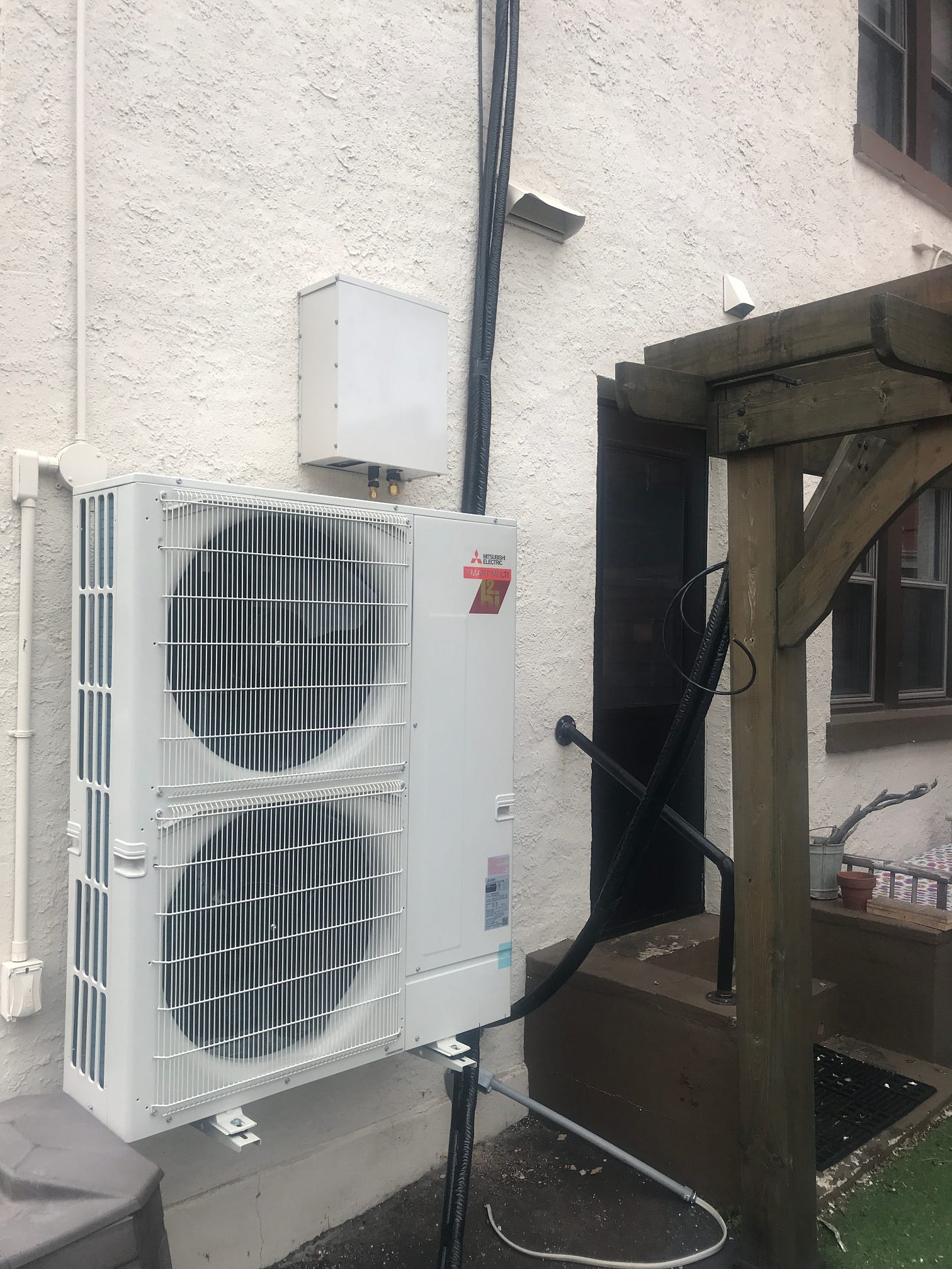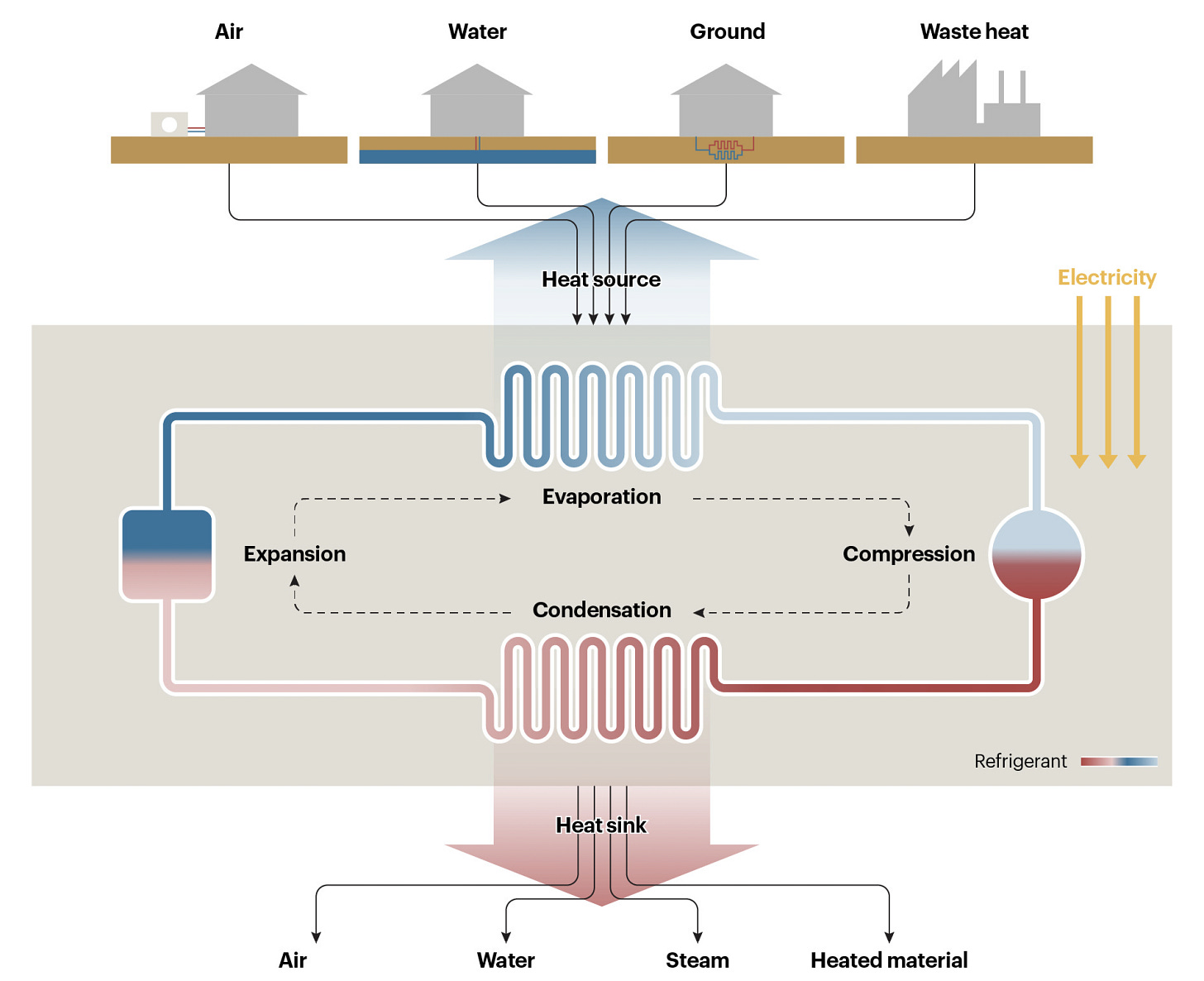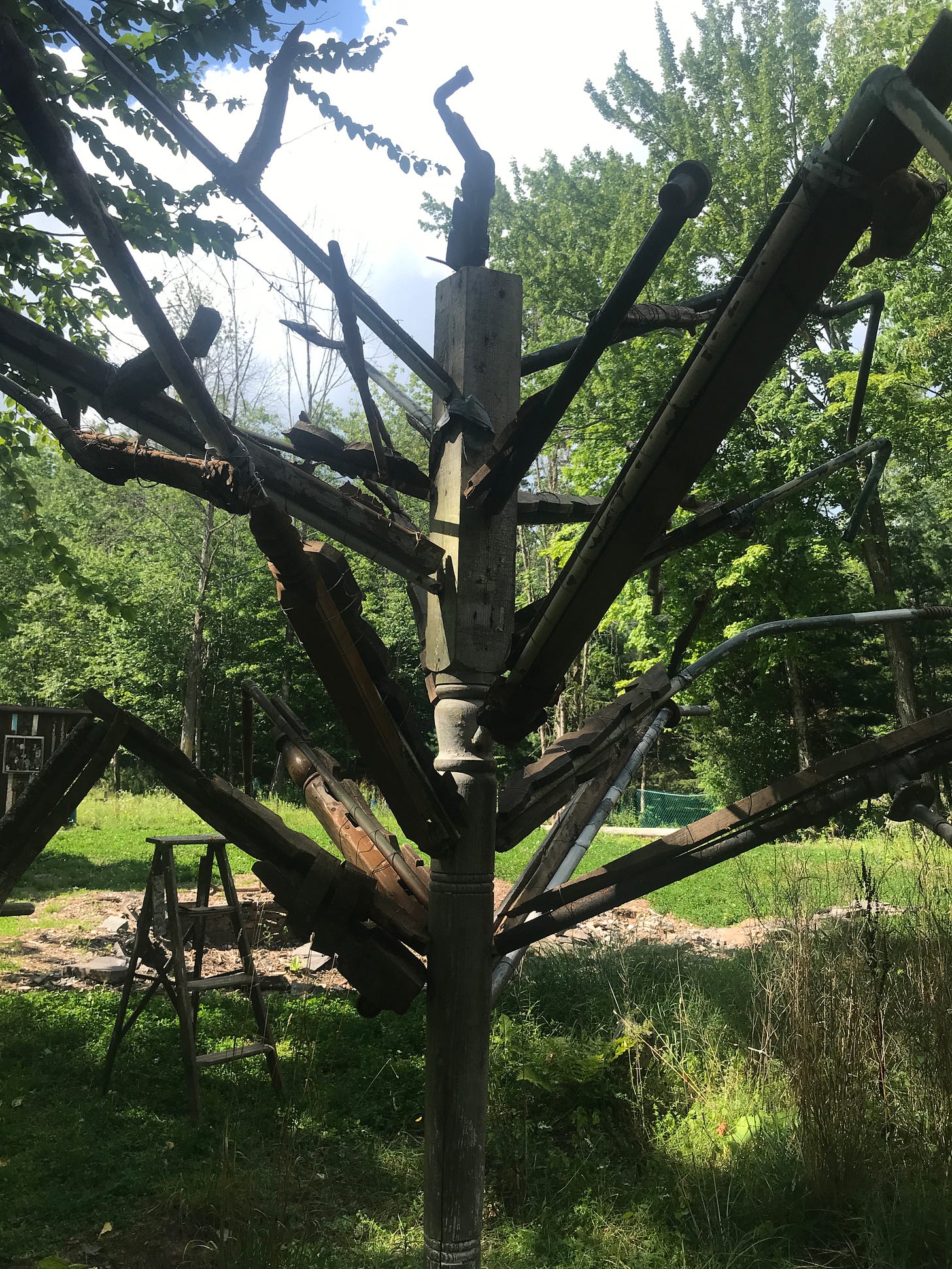My ongoing off-gassing has grown big enough I gave it its own section of my Substack here, so as my journey continues so too will this list. Thus far, I’ve covered:
Danger + Opportunity—exploring the use of “crisis” when attached to climate- or midlife-.
An Ode to Induction—on my efficient electric cooktop and not cooking with gas.
The Power to Choose—urging everyone to go with a 100% sustainable energy provider, if you can afford to.
The order to my process in my own home is loosely guided by Nate Adam’s article “Electrify Everything,” but there’s no right way to do this beyond just beginning. Now’s the part where I get to the point where There’s No Turning Back.
Getting an induction stove or switching to 100% renewable energy are relatively low-commitment, low-hanging fruit items, but now I’m talking about ripping out the perfectly acceptable existing HVAC system in my house and really pulling the plug on gas—or cutting the pipe would be a more apt metaphor for that. And now it’s time to spend big money in ways that might feel pretty scary, fiscally impossible or geographically dubious, especially if you’re in a northern, colder climate. (At least I thought I lived in a more northern, colder climate until we just hit 90 degrees in early April and had the saddest sniffle of snow this winter, so who really knows anymore; and therein lies my motivation to try to hurry up and do my part to help tourniquet the global warming bleeding.) This stage of the journey might not be for the faint of heart or light of wallet, but should you go full-electric with your HVAC, one unexpected result (more below) is you do get more friends or at least further concretize a few thematic ones. I immediately got inaugurated into this little society of certain neighbors. When us heat pump people (or geothermal people should you be even cooler than us) find out about each other, we start nerding out comparing our kWh usage or mapping out our configurations.
When I wanted to install heat pumps, a local friend who had done the same came over to help me assess what was best for my house, a similar size and footprint and age to his house. Then when I was done with the project, another neighbor who rents a parking space in my driveway couldn’t help but notice my big outdoor forever-humming unit, so now we regularly bond over our #netzerogoals.
What’s a heat pump and how does it work? MIT Technology Review has a solid overview of this, in an article they begin with:
We’re entering the era of the heat pump.
The concept behind heat pumps is simple: powered by electricity, they move heat around to either cool or heat buildings. It’s not a new idea—they were invented in the 1850s and have been used in homes since the 1960s. But all of a sudden, they’ve become the hottest home appliance, shoved into the spotlight by the potential for cost savings and climate benefits, as well as by recent policy incentives.
Simple though the basic idea may be, the details of how heat pumps work are fascinating. In the name of controlling your home’s temperature, this device can almost seem to break the laws of physics. Heat pumps are also getting better: new models are more efficient and better able to handle cold weather.
Thanks to the refrigerant liquid that turns into gas moving through the system when it’s compressed and expanded, hot air it “soaks up and releases” can be moved inside to outside (when the unit acts as an AC), or outside to inside (when you need heat), even when the temperatures outside are below freezing. This process is highly efficient (300-400%, meaning it can produce 3-4 times the amount of heat than it uses in electricity) since it’s not creating heat but moving it; and yes it even works in extremely cold climates, better than ever. If you need to go further into this or want to better understand this graphic, I recommend you let the MIT geniuses help you here.
In my home, the natural gas line formerly powered my dryer, my heat system, the hot water tank, and my stove. The stove I replaced with induction. The dryer I just shut down and will let sit there indefinitely. I have one of those two-fer units with the dryer on top. It is not detachable and frankly I never used the top half. I hang out my laundry on a clothesline in the warmer months and in the cooler months, I have racks in my basement. I justify this in many ways—it saves money of course and is better for the environment, but also the clothes will last longer, if be less cozy initially. There is that crunchiness to towels at first, but that doesn’t bother me. So new washer/dryer is on the future list of someday items, should I ever have a once-in-a-lifetime need for a dryer. More likely is just a new washer someday, maybe when my kids have graduated from college, but for now the top half can stay decommissioned and serve as an unlikely cabinet to hide any Christmas presents I buy early.
I had three contractors come to give me quotes on a heat pump system, one recommended from the neighbor friend. My preexisting system was a network of piped hot water radiators attached to a gas boiler and water tank. The first vendor was through the Sealed program. I was least impressed with their prices, their cursory plan, and their deal which seemed like too much small print for me with one of those contracts where you continue to pay your old electric bill but it’s really paying them off. They proposed 100% mini-splits since they don’t do any ductwork, so their vision for my ductless house was basically a small unit mounted in every room. That might have worked well for the right price but I also have a small house and taking up precious wall space in every room, if even a little, is too much of an ask and too much a loss for my weird art.
Plan 2 was from the friend-recommended contractor who spent a long, thorough time in my house crafting what may very well have been the best-of-both-worlds plan for me. He outlined a ducted vision for the upper floor (attic air handler unit flowing into each of three bedrooms and bath); with mini-splits downstairs for basement, kitchen and living room. Heat-pump-friend preferred this plan too. Now that I am living with plan 3, I think this might have worked better, but it was significantly more expensive so I felt I had little option but to go with 3:
Most local guy (and I’m admittedly partial to the most local of vendors), who inherited his dad’s HVAC company, proposed the cheapest plan by far with 100% ductwork. There would be two big units, one serving the upstairs rooms as the second guy proposed, with another serving the lower rooms. There would be almost undetectable vents in ceilings and floors with the uglier bits of the system in the attic and basement.
How about the price? Gulp. Government incentives are at their best right now. That said, I’m pretty sure these companies raise their prices in order to give you the great government reduction. When I did this in early 2022, my rebate for just cutting the gas line was a wonderful $17,500 upfront from NYSERDA. I don’t want payment plans, but I’m ok getting a new credit card if there’s a year of 0% APR and a cash bonus. So as long as I know it’s realistic to pay the card down before the year is up, it’s game for forming my own self-loan, and I consider the cash bonus an additional rebate on my bill (points earned $563.74). And tiny future bonus: small deduction in 2023 tax return (only $253 in my case).
Starting price of project $41,261.63, which believe it or not was the cheapest going. This plan also included a new very efficient electric water tank and removal of radiators for $750.
Still, that’s almost $25K for total gas decommissioning (including stove) when all is said and rebated, which is still kind of nuts and I can blame my bad pandemic-timing for everything being more expensive than usual, from parts to labor. Perhaps the price would be better now? The Inflation Reduction Act offers 30% tax credit on the purchase price of a heat pump, with additional rebates for low- and moderate-income households. You can try the calculator on Rewiring America to see what IRA subsidies you qualify for. While I won a mere $253 in tax credits, you could now get up to $2,000. Story of my impatient life!
Unexpected extra results that came with this price tag:
More space—I increased the square footage in my house by what felt fairly significant since each room has such a small footprint to begin with. Cutting out almost a dozen big clunky iron radiators meant also cutting out the networks of skinny water pipes attached. Suddenly every room that had a radiator or two that behaved like ugly furniture I was stuck with, like it or not, was removed and the room grew room for things we really wanted like a chair or a shoe stand. Had I tried harder I could have probably sold these crazy heavy iron contraptions for scrap or at least had them removed for free so someone could sell for scrap, but I gave up and had the HVAC guy do it when the only one who cared on Facebook Marketplace was a scammer. (“My wife is coming right now to get them, can I have your cell number.” Wait, what? That’s some wife!)
Petty cash—While the radiators didn’t sell, I did make some handy cash on my nice vintage radiator covers, each customized to my space so I really had a size for anyone. That won me $315, plus the $50 I got for my old stove.
A pipe tree—Everything to me has creative potential, even a tangle of long skinny water and gas pipes I accumulated in a pile in my driveway. I brought them upstate to my bit of land and did what any odd duck like myself would do—create a pipe tree of course. Work in progress as I further treeify the thing (it needs leaves), but here’s where it’s at currently:
Just like the ET house!—I explained to my girls we now have two public-facing floors each powered by another uglier floor. The basement deals with the living room/kitchen and the attic runs the bedrooms/bathroom. The attic and basement are where all the ducting magic happens—if you want to call the vented tent house scene in ET “magic.” There’s a lot of exposed silver tubing happening down below and up above. In my storage-only attic, this matters not at all and there’s still plenty of room for my storage. Downstairs though is our rec area (a craft room and a bit of a TV/game room with the laundry). There used to be a boiler taking up a dark creepy corner, now that’s just overhead in an exploded array of silver tubes spidering out from the ceiling-mounted handler. I’m pretty sure this can all more aesthetically pleasing someday should I remove the dropped ceiling and smush these tubes into some disguised channels a little higher up. But I didn’t pay for pretty, and maybe I can just decide it’s punk rock and embrace it. Here’s my house:
And here’s the scene when the officials invade Elliot’s house and turn it into a tubed tent camp that now reminds me of my basement:
And how’s it all work? Who knows! I haven’t fully tested it all since I don’t run much AC in the summer (I prefer the ceiling fans I have in every room) and over the winter I lowered the thermostat to sub-human levels so I’d survive my upgrade to more expensive 100% sustainable energy. Now it’s onto saving for the next project: solar. And then I’ll happily let the system go full speed and report back.











Love the pipe tree and cost savings breakdown
Cool!